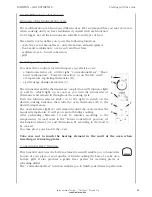
47
Installation Guide - "Château" Range G4
08NOTINSTALG4/EN-1
BEFORE DELIVERY
Electrical & Gas supply
Voltage:
220 - 240 V a.c., single-phase + n ground
400 V a.c. 3N, three-phase + n ground.
50 / 60 Hz
Safety:
The electrical supply must necessarily be grounded and must be equipped with
a circuit breaker protection
compatible with the appliance’s power rating.
When a cooker is hooked on 400 V tri-phase, the circuit breaker must be a 4-line breaker
(3 phases and neutral must be cut).
In high-risk regions, an additional protection against natural electrical phenomena
(lightning) must be used.
A disconnection system must be provided in accordance with standard regulation.
Power:
It is advisable to check whether the power rating of your electrical installation provides
you with sufficient power for your model, taking into account any electrical appliances
you have already installed. Refer to the tables for each of the models for the total power
and current ratings.
The overall wattage of your appliance is also indicated on the rating plate and on the
warranty certificate (See pt.4, page 13 for the location of the plate).
Due to the power of La Cornue appliances, a simple plug and socket connection is not
recommended: the electrical connection should consist of a flexible cord without a plug,
directly connected to the circuit breaker outlet by means of a junction box with terminal
blocks, preferably of the anti-shearing type.
Only all-gas hobs with only hob burner ignition can be connected with an ordinary 3-pin
plug.
The gas installation must comply with the current regulations in the country
where the appliance will be installed.
Reminder of the main obligations with regard to gas installations:
The gas must be supplied via a rigid metallic pipe, terminated by an easily accessible
manual shutoff valve.
This valve must be positioned, taking into account that the gas inlet on the appliance is
situated:
· on the left of the cooker or the hob.
· at the level of the work area (on the bottom left) for hobs.
3. G
AS SUPPLY
2. E
LECTRICAL
S
UPPLY
















































